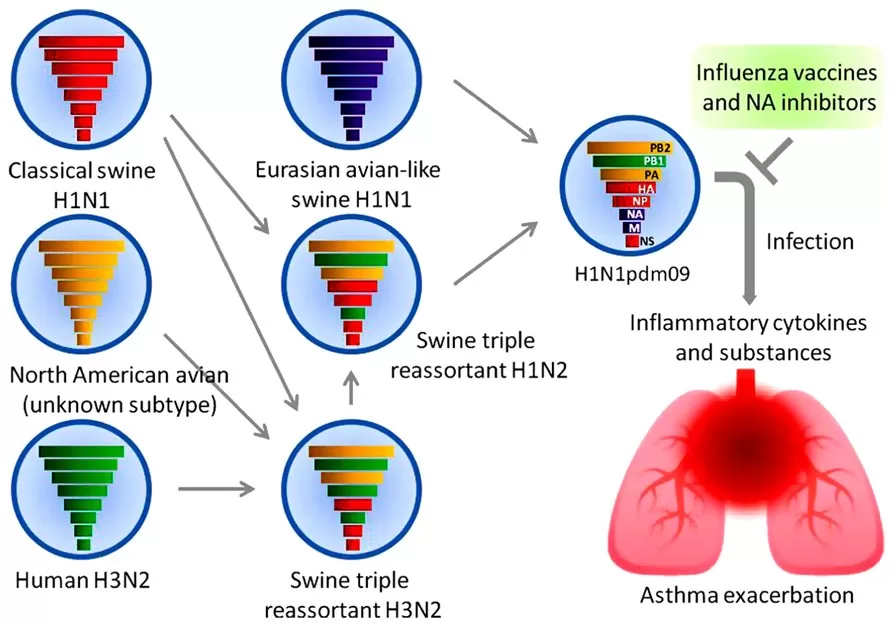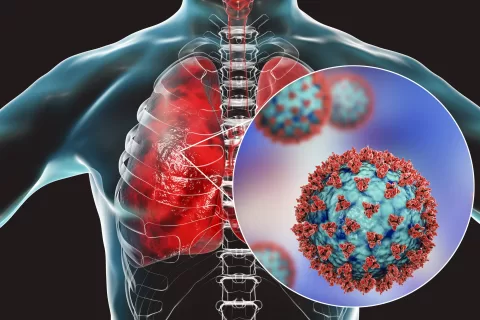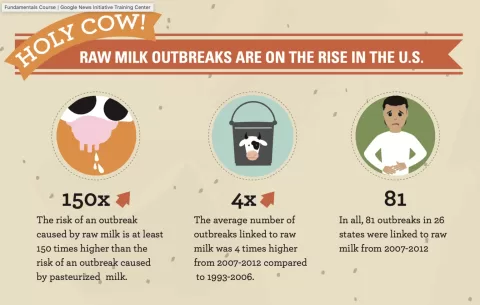The H1N2v flu strain has recently captured the attention of health officials as the CDC confirms a rise in variant influenza cases across the United States. This year, there have been a total of 12 reported H1N2v cases, demonstrating an increase in infections — particularly in states like California and Ohio, where recent outbreaks were noted. Health experts stress the importance of monitoring variant flu strains such as H1N2v, especially with the reported connections to swine exposure in agricultural settings. The latest CDC flu report suggests a critical need for early detection and investigation to mitigate the spread and potential risks associated with these influenza variants. As further research unfolds, public health organizations continue to alert communities about the significance of awareness around variant strains amid concerns about the season’s overall flu activity.
The variant influenza known as H1N2v has emerged as a notable public health concern, especially as officials record new cases in various U.S. regions. Also termed “variant flu strains,” these infections showcase the evolving landscape of influenza viruses, highlighting the ongoing efforts from agencies like the CDC to monitor and respond to outbreaks effectively. As defective strains like H1N2v increase, detailed reports and investigations become essential in understanding transmission dynamics and preventing wider outbreaks. Situations involving such flu variants indicate an urgent need for public health outreach, especially surrounding recent agricultural fairs where swine contact was noted. Keeping abreast of these developments is vital not only for informing treatments but also for coordinating public health responses to related diseases.
Understanding H1N2v Flu Infections
The H1N2v flu strain, a variant of the influenza A virus, has been recently highlighted in the CDC’s report as cases continue to rise across several states, notably California and Ohio. This variant flu strain is contracted primarily from swine, especially during agricultural fairs. The current increase in cases, amounting to 12 in total this year, reflects a growing concern among public health officials. The CDC emphasizes the importance of monitoring these infections closely, considering they can lead to significant outbreaks if not managed properly.
Patients infected with H1N2v flu, including the latest cases, have exhibited mild symptoms, which raises questions about the virus’s overall severity. Fortunately, none of the young children infected this year have required hospitalization, and most are recovering well. Monitoring these infections is crucial not only for public health safety but also to inform next steps in vaccination strategies against various influenza variants. Coordination between state health departments and the CDC is essential to contain potential risks associated with H1N2v flu.
Recent CDC Report on Influenza Variants
The CDC’s flu report reveals a concerning situation regarding influenza variant strains, particularly highlighting the emergence of novel strains such as H1N2v and H3N2v. While H3N2v has been more prevalent in the past, the increase in H1N2v cases signifies a shift that public health analysts are watching closely. The report mentions that since 2011, the total number of H1N2v cases has now doubled, indicating a potential trend that could affect flu seasons in the future. The CDC’s continued surveillance and reporting play a vital role in understanding the implications of these variant viruses on public health.
Analysts warn that these variant strains can lead to complications, especially among vulnerable populations such as children and the elderly. The rising number of H1N2v cases necessitates public awareness campaigns and further investigation into their transmission routes. Moreover, understanding these variants’ implications can lead to better public health responses and enhanced vaccine formulations to ensure community health is safeguarded.
Emerging Threats: The CDC and Cyclospora Outbreak
The recent outbreak linked to McDonald’s salads has notably raised public health concerns, with over 500 confirmed cases of Cyclospora reported by the CDC. This foodborne illness, caused by the *Cyclospora cayetanensis* parasite, has resulted in multiple hospitalizations. The emergence of such outbreaks underscores the need for stringent food safety practices and monitoring systems to prevent future occurrences. The complexity of tracking *Cyclospora* infections, given the delay in symptom onset and reporting, makes it imperative for health officials to act swiftly.
With the identified source of the outbreak being traced back to a specific salad mix, the FDA’s involvement is crucial for ensuring rigorous checks on food distribution channels. As investigations continue, the collaboration between the CDC and FDA will be paramount in analyzing distribution data and addressing any lapses in food safety that might have contributed to this outbreak. Public health education on symptoms and preventive measures is key to managing current cases and mitigating future risks.
The Cyclospora outbreak also reflects a broader problem of foodborne illnesses, which continue to challenge public health systems. As such, continuous public awareness campaigns and efficient reporting systems for foodborne diseases are needed to enhance community resilience against similar threats.
Frequently Asked Questions
What are the recent H1N2v flu cases reported by the CDC?
As of August 24, 2018, the CDC confirmed four additional H1N2v flu infections, bringing the total to 12 cases for the year. Most cases were reported in California and Ohio, with a significant history of exposure to swine at agricultural fairs.
How does the H1N2v flu compare to other variant flu strains?
The H1N2v flu strain, identified as a variant of the influenza A virus, is less common compared to other strains like H3N2v. This year, only one H3N2v case was reported while the H1N2v cases doubled from previous years.
What public health measures are suggested by the CDC for managing H1N2v flu cases?
The CDC emphasizes the importance of early identification and investigation of H1N2v flu infections to understand the transmission risk and implement appropriate public health responses to prevent further cases.
Are there any notable risks associated with H1N2v flu in children?
Recent reports show that children make up a significant number of H1N2v flu cases, but all recent cases did not require hospitalization and most recovered without severe complications, highlighting the need for monitoring but not immediate alarm.
What steps should be taken following exposure to H1N2v flu?
Individuals who were in contact with swine or showed symptoms consistent with H1N2v flu should seek medical advice and potentially get tested to mitigate further transmission risks.
Has there been any link between the H1N2v flu and the Cyclospora outbreak?
Currently, there is no evidence correlating H1N2v flu cases to the Cyclospora outbreak linked to McDonald’s salads, as they are separate public health concerns being monitored by health authorities.
What information is available on vaccines for variant flu strains like H1N2v?
Vaccination against seasonal influenza may offer some protection, but specific vaccines for variant strains like H1N2v are not widely available. Awareness and preventive measures remain crucial during outbreaks.
How can I stay informed about H1N2v flu developments?
Regular updates are provided by the CDC and local health departments. Staying informed through credible health sources and ensuring adherence to public health guidelines is recommended.
What symptoms should I watch for regarding potential H1N2v flu infection?
Symptoms of H1N2v flu may include fever, cough, sore throat, body aches, and fatigue. Monitoring for these symptoms, particularly after exposure to swine, is advised.
Is there a relationship between H1N2v flu cases and swine exposure?
Yes, a significant number of H1N2v flu cases can be traced back to exposure to swine, especially during agricultural fairs. This highlights the importance of biosecurity measures in animal agriculture.
| Key Point | Details |
|---|---|
| CDC Confirms H1N2v Cases | Four new H1N2v flu cases reported in California and Ohio, raising the total this year to 12. Most patients were children and are recovering. Exposure linked to agricultural fairs. |
| Increase in H1N2v Cases | Total H1N2v cases since 2011 now at 24 after the recent confirmations, doubling the previous total. |
| Importance of Monitoring | Early identification of human infections with novel influenza A viruses like H1N2v is critical for understanding risk and implementing public health measures. |
Summary
The recent increase in H1N2v flu cases highlights the importance of vigilance in monitoring such influenza variants. The confirmation of four new infections by the CDC emphasizes a concerning rise in cases, particularly among children who have been exposed to swine at agricultural events. As the total number of H1N2v cases since 2011 doubles, public health agencies are prompted to enhance surveillance and preventive measures to manage the risk effectively. Early identification and thorough investigation of these infections are essential to mitigate any potential outbreaks of H1N2v flu.
The content provided on this blog (e.g., symptom descriptions, health tips, or general advice) is for informational purposes only and is not a substitute for professional medical advice, diagnosis, or treatment. Always seek the guidance of your physician or other qualified healthcare provider with any questions you may have regarding a medical condition. Never disregard professional medical advice or delay seeking it because of something you have read on this website. If you believe you may have a medical emergency, call your doctor or emergency services immediately. Reliance on any information provided by this blog is solely at your own risk.








